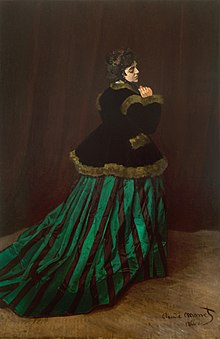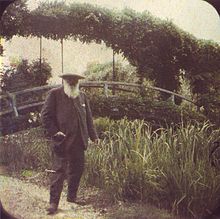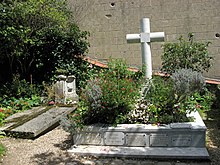Claude Monet


Claude Monet [ klod mɔnɛ ] (born November 14, 1840 in Paris , † December 5, 1926 in Giverny , born Oscar-Claude Monet ) was an important French painter whose middle creative period was assigned to the Impressionist style .
His early work up to the mid-1860s included realistic paintings, some of which Monet was allowed to exhibit at the Paris Salon . In the late 1860s, Claude Monet began painting Impressionist pictures. An example of his pictures from this creative phase is Impression, Sunrise , a harbor view of Le Havre , which gave the entire movement its name. In this way he moved away from the taste of the time, which was shaped by the traditional art academies, which worsened his financial situation.
In the 1870s, Monet took part in some of the Impressionist exhibitions, in which artists such as Pierre-Auguste Renoir or Edgar Degas took part, and was primarily sponsored by the art dealer Paul Durand-Ruel .
Monet's financial situation remained tense until the 1890s. During this time, Monet developed the concept of the series, based on which he painted a motif in different lighting moods. In addition, he began to lay out his famous garden in Giverny , which he subsequently used as a motif for his pictures.
Life

Claude Monet was born on November 14, 1840 at 45 Rue Lafitte in Paris. He was the second son of Adolphe Monet and his wife Louise Justine Aubrée. He was baptized Oscar-Claude Monet in Notre-Dame de Lorette Church, and his parents always called him Oscar. His father owned a grocery store . His economic situation deteriorated so much around 1845 that the family moved to Le Havre at the mouth of the Seine , where the father's half-sister, Marie-Jeanne Lecadre, lived. Her husband, Jacques Lecadre, was a grocer and ship supplier and offered Monet's father work in his trading company. The Monets family spent the winters in their home in Le Havre, and the summers they stayed in the Lecadres country house in the northern suburb of Sainte-Adresse . He later moved with his family to a neighboring village, but the family did not stay long there, as Adolphe Monet had to move for professional reasons.
In Le Havre, Claude Monet attended the municipal high school between 1851 and 1857, where he received drawing lessons from Jacques-François Ochard . He rejected school discipline and preferred to stay on the cliffs or by the sea instead. In class, Monet made caricatures of students and teachers, which were displayed in the window of the only frame dealer in Le Havre. By the age of 15, Claude Monet was known throughout the city as a cartoonist. He received orders for which he was able to obtain prices of 20 francs. They were all signed by O. Monet (see cartoon by the notary Léon).
education
In addition to his caricatures, seascapes by the painter Eugène Boudin were exhibited in the window of the frame dealer . Claude Monet did not like these pictures and refused to meet Boudin through the intermediary of the frame dealer. However, when he did not notice Boudin when entering the shop, the dealer took the opportunity to introduce Boudin to Monet as the cartoonist. The painter praised Claude Monet's talent, but also advised him not to be content with drawing and suggested that he paint landscapes.
After the death of his mother on January 28, 1857, Monet's aunt, who was a hobby painter herself and had contacts with Armand Gautier , worried about the young Claude Monet. After Jacques Lecadre's death, Monet's father took over his business and moved his family into his house. It was in that year that Monet's first landscape painting was done and he decided to become a painter. His father then applied to the Le Havre magistrate for a scholarship, which, like a second application in the following year, was rejected. Even so, Monet traveled to Paris to visit the Salon de Paris exhibition . He also made contact with artists such as Constant Troyon and Armand Gautier and worked in the studio of the painter Charles Monginot , who was a friend of Boudin. During this time, Monet received financial support from his father. In addition, Claude Monet had 2000 Francs at his disposal, which he had earned with his caricatures and which his aunt administered for him. In 1860 his father's financial support diminished because he refused to enter the École des Beaux-Arts , as his parents wanted . Monet entered the free painting school Académie Suisse , where he mainly dealt with figure studies. Monet visited exhibitions at the artists' colony in Barbizon . The painters of the Barbizon School rejected the popular idealizing landscape compositions and instead preferred landscapes in the style of realism . Claude Monet also stayed in the Brasserie des Martyrs , which was a meeting place for many modern artists and authors.
In April 1861 Claude Monet was called up for seven years of military service. It was possible to buy oneself out of military service for 2500 francs. However, Claude Monet did not have enough money for this, and his family would only provide the sum if Monet would give up painting and take over the business in Le Havre. He decided to paint and was assigned to the cavalry in Algeria . Because he fell ill with typhus , he was allowed to return to Le Havre in the summer of 1862. There he met Johan Barthold Jongkind from the Netherlands . Together they both worked on landscape studies. In November 1862 Claude Monet was ransomed from military service by his aunt for the even higher sum of 3,000 francs in order to spare him the last six years of service. She assigned him Auguste Toulmouche , the genre painter and husband of Marie-Jeanne Lecadres' cousin, as artistic supervisor. He recommended Monet to join Charles Gleyre's studio , in which Pierre-Auguste Renoir , Alfred Sisley and Frédéric Bazille were also enrolled. Together with Bazille, Monet traveled to Chailly near Barbizon over Easter in 1863 and painted landscapes there, as in the following year. He also continued his studies with Gleyre until his studio closed in July 1864. During the summer, Monet, Bazille, as well as Jongkind and Boudin, who followed later, painted on the Channel coast of Normandy . Monet's family threatened him with the suspension of financial aid as a result of disputes, so he asked Bazille for money for the first time. During his studies, Monet was bourgeois , for example, despite his difficult financial situation, he wore shirts with lace cuffs and was called a dandy by his fellow students .
Salon exhibitions
In 1864, a flower still life by Claude Monet was exhibited at the Rouen Municipal Art Exhibition . In addition, Monet was commissioned by Louis-Joseph-François Gaudibert to paint two portraits. This commission was of particular importance to him because Gaudibert's son later commissioned portraits and also gave him financial support as support. At the end of 1864 or beginning of 1865, Claude Monet and Frédéric Bazille founded a joint studio in Paris. In the Paris Salon of 1865, Monet was allowed to show two seascapes . These two pictures met with positive criticism, which prompted Claude Monet to plan a monumental breakfast in the countryside for the salon exhibition in 1866 , which he was unable to complete. His model was Camille Doncieux , with whom Monet entered into a relationship. The picture was planning Monet following the Luncheon on the Grass by Édouard Manet , which caused a scandal by nudity depicted without mythological background, but Monet wanted to keep his image more conservative and therefore the taste of the masses accordingly. Monet admired the works of Manet, with whom he had been in close contact since 1866. When he could not finish the planned picture for the salon , he painted Camille in the green dress within four days , which was positively received in the salon.
Claude Monet pretended to break with Camille due to his financial difficulties and thus again got closer to his family, from whom he hoped for financial support. He spent the summer of 1867 with his parents in Sainte-Adresse, while the pregnant Camille continued to live in Paris and was cared for by Bazille. On August 8, 1867, she gave birth to Monet's first son, Jean. Not wanting to abandon his lover and his son, Monet returned to Paris. In the same year, Monet's painting Women in the Garden was again rejected by the Salon de Paris . In order to support his friend financially, Bazille bought this work in installments and took it back to his studio. Claude Monet's financial situation remained difficult, so that he stayed in Étretat and Fécamp in 1868 , where he again received orders from the shipowner Gaudibert. In addition, this triggered the seized pictures of Monet. At the end of the year, Monet fled from his creditors to Paris again. In 1870 another picture submitted by Monet to the Salon de Paris was rejected by the jury. On June 26 of this year, Claude Monet married long-time lover Camille Doncieux. Through his choice of topics and painting style, Monet moved further and further away from the Salon de Paris and thus also from commercial success.
With the beginning of the Franco-Prussian War in July 1870, Claude Monet left France and moved to London to avoid being drafted into the army, while his friends Bazille and Manet went to war. On November 28, 1870, Bazille died at the front. During his stay in London, Claude Monet met the art dealer Paul Durand-Ruel. He learned to appreciate the works of the English landscape painter William Turner , in whose pictures the contours dissolve in the light. Monet's father died on January 17, 1871, and he received a small inheritance. After the end of the war, Monet returned to France in autumn 1871 after a detour via Holland . There he rented a house with a garden in Argenteuil . With the money from the inheritance and the dowry from Camille, the family was able to live in bourgeois prosperity for the first time. In 1872 Durand-Ruel bought several paintings by Monet. He set up a boat as a studio and painted on it on the banks of the Seine.
Impressionist exhibitions
In 1873 Claude Monet met Gustave Caillebotte at Argenteuil , with whom he decided to organize joint exhibitions. In December, the "Sociéte Anonyme Coopérative d 'Artistes-Peintres, -Sculpteurs, -Graveurs, etc." was founded for this purpose . This society also joined the artists who were later considered to be the core of the Impressionists.
The first group exhibition took place in 1874 in the studio of the photographer Nadar on the Boulevard des Capucines in Paris. Based on the title of the exhibited work Impression - Sunrise , which Monet had painted in Le Havre in 1872 together with other pictures, this exhibition was disparagingly referred to by the critic Louis Leroy in the magazine Le Charivari as "The exhibition of the Impressionists". The concept of Impressionism , which was initially used mockingly by critics and subsequently also by the artists themselves, was justified by this picture of Monet. The exhibition went largely unnoticed and the society was dissolved at the end of 1874. The second Impressionist exhibition did not take place until 1876. Claude Monet exhibited 18 works in the premises of the art dealer Durand-Ruel. In that year Monet also met Ernest Hoschedé , a department store owner, who commissioned him to paint panels for a hall in his Rottembourg castle in Montgeron . Monet's second son, Michel Monet, was born on March 17, 1878 . In the summer of that year the family moved to Vétheuil . They were followed by Alice Hoschedé with her six children after her husband had to file for bankruptcy. On September 5, 1879, Monet's first wife Camille died at the age of 32 as a result of an unsuccessful abortion .
In 1881 Durand-Ruel bought more of Monet's paintings and also financially supported Monet's painting trips to the Norman coast in 1882. In December 1881, Claude Monet and Alice Hoschedé moved with their children to Poissy . The Impressionists' exhibition of 1882 was the last Claude Monet took part in before the series of exhibitions ended four years later with the eighth exhibition. At this point in time, his turning away from the other impressionists, who accused him of no longer supporting the group out of selfish motives, became increasingly clear. Monet tried to exhibit again in the Salon de Paris and one of his pictures has now been accepted by the jury.
Giverny
In 1883 Durand-Ruel organized a solo exhibition of Monet's paintings. This exhibition received positive reviews, but there were no major sales. Nevertheless, Monet's economic situation improved after the market for Impressionist works had revived at the beginning of the 1880s. Claude Monet rented the house in Giverny , in the vicinity of which he laid out his famous garden in the following years, and moved in with his two sons, as well as Alice Hoschedé and their children.
In December 1883 he traveled with Renoir to the French Mediterranean coast , from January to April 1884 Monet painted on the Riviera . Another trip to Holland followed two years later. In the autumn of 1886 Monet painted in Brittany , where he met his future biographer Gustave Geffroy . From January to April 1888 Monet painted on the Côte d'Azur and traveled to London again that summer. On his return to France he rejected the Cross of the Legion of Honor . The following year, Claude Monet collected money to buy the painting Olympia from his friend Manet's widow and donate it to the Louvre.
In 1890 Monet bought the house in Giverny, which he had lived in for seven years after having found himself in a better financial situation due to regular sales since the mid-1880s. Through further acquisitions of land, Claude Monet continued to expand his property and invested a lot of money in the construction of his garden. In doing so, however, he encountered the distrust of the local farmers, who feared that the exotic plants such as tuberose from Mexico could pose a threat to their land and cattle. In the late 1880s, a small group of American painters came to Giverny to learn from Claude Monet. Among them was Theodore Robinson , who was one of the first American artists to take up impressionism in his art. Monet did not maintain close contact with the so-called "Givernists" because he never wanted to take on the role of teacher.
Monet also commented on the Dreyfus affair . On January 15, 1898, Le Temps published a petition, which Monet had also signed, calling for a revision of the misjudgment against Alfred Dreyfus . This petition was supported by Émile Zola and many well-known personalities from various fields.
Ernest Hoschedé died in 1891. Claude Monet and his widow legitimized their relationship by marriage in July 1892. In the same year, Monet's stepdaughter Suzanne married the painter Theodore Butler , who was a Givernist. Monet traveled to Norway in 1895 and also visited his stepson there.
Claude Monet built a second studio in Giverny in 1897 because he needed more space for his work. 20 works by Monet were exhibited at the Biennale di Venezia . That summer, Monet's son Jean married his stepsister, Blanche Hoschedé .
Claude Monet made several trips to London in 1899 and 1900. Together with Alice, Monet traveled by car to Madrid in 1904 , where he studied the Spanish masters such as Velázquez and El Greco . In Giverny, meanwhile, he mainly worked on the water lily pictures, but was not satisfied with it. Therefore, in 1906, he postponed an exhibition planned at Durand-Ruel several times.
Last years of life and death
In 1908 the first signs of Monet's eye disease appeared. From October to December of that year he and his wife set off on their last trip to Venice. There he not only painted, but also studied works by artists such as Titian and Paolo Veronese in churches and museums . On May 19, 1911, Monet's second wife Alice also died. The following year his eyesight continued to deteriorate and a double-ended cataract was diagnosed. In 1912, 29 of Monet's 37 paintings from Venice were exhibited in the Bernheim-Jeune gallery with great success .
In 1914, Georges Clemenceau and other friends of Monet suggested that he donate pictures of the water lily series to the French state. But Monet, who had previously rejected declarations of honor by the state, could not be persuaded to donate. After the death of his son Jean Monet, his widow took over the management of the household in Giverny. There Monet had a third, larger studio built in 1915, in which he painted the water lily decorations. At the end of the First World War with the armistice on November 11, 1918, Monet gave eight of his water lily pictures to the French state. In 1921, depressed by the deteriorating eyesight, he considered withdrawing the donation. In the same year, a major retrospective of Monet's works took place at Durand-Ruel . It was not until 1922, at the insistence of his friend Clemenceau, that Claude Monet signed a notarized contract for the donation, which became legally valid and the pictures actually became the property of the state.
Monet regained his sight through two operations in 1923 . He started painting again on his large water lily decorations, but was hampered by depression. Monet himself destroyed many of his paintings in recent years because he did not want unfinished works as well as sketches and experiments to end up in the art market after his death, as was the case after Manet's death. Claude Monet died in Giverny on December 5, 1926.
plant
The early work

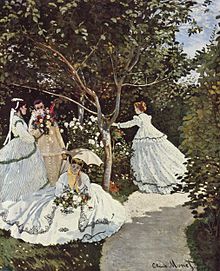
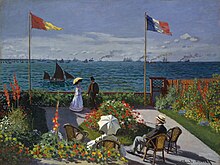
Monet painted the picture Breakfast in the Green in 1865 and 1866 for submission to the Salon de Paris . The picture originally had a total size of 4.20 mx 6.50 m. Because of his debts, Monet left it to his landlord as a pledge and redeemed it after a few years. However, it showed great moisture damage and was partially moldy . He restored the picture but was only able to restore two parts. Claude Monet's breakfast in Manet's Greenery from 1863 served as a model for this work. Manet's picture showed a naked woman between two men in urban clothes at a picnic in a forest clearing and triggered a scandal with the nudity, which is not linked to myth . Claude Monet was enthusiastic about this work by Manet and orientated himself on it. In contrast to Manet's picture, his breakfast in the country should not be made in the studio alone, but in the open air. Another difference was the lack of provocation; Monet wanted to adapt to the taste of the crowd because he was still looking for recognition in the Salon de Paris . For the figures in the picture, Monet's lover Camille and his friend Bazille sat and stood as models in the forest of Fontainebleau , which he recorded in a preliminary study. He transferred this to large format in his studio in Paris from around October 1865, but had to realize shortly before the start of the Salon de Paris that the picture would not be ready in time. Claude Monet's picture in its original form showed twelve people dressed in the Parisian fashion of the time having a picnic in a birch forest. The main focus is on the characters shown, whose behavior Monet portrayed individually. They are grouped around the white picnic blanket on which the food is presented. Claude Monet created an intimate natural space in the picture, in which the people stay far away from urban conventions . This mood is mainly created by the play of light and shadow in the picture.
In 1866 Claude Monet painted another figure picture with the women in the garden , which shows several people. In contrast to breakfast in the country , Monet did without preliminary studies and their transfer in the studio for this picture. So he started the 2.55 mx 2.05 m painting directly in the open air, but had to finish it in the studio in Honfleur because he had fled from his creditors. In order to be able to paint the upper parts of the picture, Monet developed a device with which he could lower the picture into a dug hole in the ground. The colors used are overall lighter than in Monet's earlier works, as he mostly mixed them with white . In addition, instead of modeled transitions, there is increasingly a rhythmic division into short or wide brushstrokes and dots. For the women in the picture, with the exception of the woman on the right, Camille stood and sat again as a model. The position of the women formed a triangular composition that is shifted slightly to the left. In this picture, however, the figures do not appear to be integrated into nature. The picture shows no reason for the gathering of the women who pick flowers and Monet does not represent their character. The picture is particularly fascinating because of the contrasts of light and shadow, especially the one that runs over the dress of the seated woman. which make it come alive. The light filtered through the parasol, in combination with the light reflected from the dress, creates a rosy glow on the woman's face.
The painting The Terrace of Sainte-Adresse , created in 1867, measures 98 × 130 centimeters and indicates the change in Monet's painting style. It shows a terrace directly on the seashore, from which the figures can watch a regatta . The seated man in the foreground is Claude Monet's father. The picture appears schematic because Monet's brushwork does not have the same lightness as in his Parisian works or those that were created later. However, the depiction of light goes beyond his previous works, because he painted the shadows in color for the first time. In addition, the flowers in Monet's garden were painted in brighter colors than was the rule in realism . He used pure red , which was particularly radiant thanks to the white light and the contrast with the complementary color green . In doing so, Claude Monet does not depict their natural form, but depicts their flowers only with splashes of color. This picture can no longer be clearly assigned to a period of Monet's style, but due to the schematic effect it is even closer to the realistic early work than to the impressionist works. In addition, Monet found with this and the same year the picture Blooming Garden in Sainte-Adresse on the theme of the garden , which he subsequently took up again and again.
Turning to impressionism



The visible reality in the pictures of the Impressionists loses its physicality and material quality and becomes a mere appearance 'impression'. It is no longer the perceived itself, but the process of perception that is represented. Several design principles are used:
- The use of pure spectral colors
- The use of the complementary contrast
- The covering instead of glazing paint application in short brushstrokes, each forming a color unit (comma technique)
Through the use of cool and warm colors both in the foreground and background, the naturalistic aerial and color perspective (dark and sharp in the front and light and out of focus in the back, as well as warm tones in the foreground and cool in the background) is abandoned, for example in the Painting Woman with a Parasol , 1886. This painting technique found the purest and most perfect form in Monet's late work from 1890 onwards.
The picture The River / On the Banks of the Seine near Bennecourt , which Claude Monet painted in 1868, is considered to be one of his earliest Impressionist works. In the foreground, a woman sits under trees on the bank of the Seine, where a boat is moored. On the opposite bank is a village that is reflected in the river water together with the surrounding landscape. The picture is painted with light brushstrokes, which can be seen, for example, from the yellow dots in the green in the foreground. The image composition is diagonal . The upper left half of the picture is dominated by the trees and their foliage, which form a privacy screen for the background. The right, lower one offers a view into the distance. The foreground of the picture is in the shade, while the other bank is in the sunlight. The reflection on the surface of the water blurs the spatial references in the image in two-dimensionality . In addition, the picture is given a special rhythm by the colored surfaces, which hardly differ despite the different objects depicted. Thus, for Monet, water is a means of abstraction and a step towards abstract painting .
One of the most important images of Impressionism is Monet's Impression, Sunrise from 1872, which gave the art style its name. The picture is a seascape and shows the port of Le Havre in the morning. Ships are anchored in the background, disappearing in the fog. In the foreground of the picture three smaller boats can be seen in the shadows. The light of the rising sun is reflected on the water. Claude Monet painted most of the picture with light brushstrokes and colors such as blue and purple , he painted the reflection of the sun on the water with a few strong orange strokes. The ships in the background serve as a structuring element of the picture, their masts and outlines creating linear structures despite the fog. The picture is painted flat, so that the impression of the spatial distance only becomes clear due to the diagonally arranged small boats. Because of its sketchiness, the work came under heavy criticism. For example, the art critic Louis Leroy wrote : “A wallpaper in its original state is more elaborate than this seascape.” In addition, Leroy referred to the first group exhibition of the “Sociéte Anonyme Coopérative d'Artistes-Peintres, -Sculpteurs, -Graveurs, etc.” based on this picture . ” As“ Exhibition of the Impressionists ”, which gave the entire style its name.
In 1879, Claude Monet painted the picture Camille Monet on the death bed after his wife died as a result of an unsuccessful abortion. The picture shows Camille, who has just passed away, with a bouquet of flowers placed on her breast, whereby her pale face can be seen above all. The facial features can only be seen vaguely. The face is detached from the space and seems to sink into the pillows of the bed. The first morning sunlight falls on the bed from the side. Nevertheless, the effect of the picture remains cool due to the chosen colors. Monet's brushstroke is disordered, powerful, but also delicate, especially in the facial area, which is a sign of Monet's state of mind at this point in time. One of the impulses for Monet to paint this picture was the varying shades and tints on the face of the dead. Monet was particularly fascinated by the sequence of purple tones during rigor mortis . In the contrast between the light of morning and the coolness of death lies the mood of the moment that Monet captured in the picture.
Monet and the Modern


Claude Monet dealt with modernity several times in his early works . So he painted several pictures related to the railway , in which the fascination of modern technology became clear. In the railway, Monet found industrial development, progress and speed symbolically united. This is already shown in the picture The Argenteuil Railway Bridge from 1873, which was a monument of the new era. This symbolism of the railway can be seen particularly well in the pictures of the Saint-Lazare train station , which Monet painted in 1877. According to Pierre-Auguste Renoir , Monet obtained permission to paint in the train station from the director of the West Railway Line after he, dressed in fine clothes, declared that he was a painter and, after much deliberation, had decided to choose the train station as his subject. He made such an impression that trains stopped for him, fired with a lot of coal to generate enough steam, and platforms were closed. Monet painted several studies from different corners of the station. The composition of the pictures is strongly influenced by the linear structures of civil engineering. The incident sunlight combined with the smoke and steam from the railways made these structures particularly effective. In the atmosphere created by this, the station appears as the “cathedral of the technical age”.
Claude Monet took up Japonism as early as 1875 . Japan did not open to the West until the middle of the 19th century. Japanese art and culture now became known to a wider mass in Europe. Japonism became a fad, especially in the western metropolises. Since his trip to Holland in 1871, Claude Monet has been collecting Japanese woodcuts , which he often used as models for pictorial compositions. For example, the picture Die Kohleträger has a main motif shifted from the center of the picture and a grid-like structure of the motif. The image motif extends far into the background of the image in a regular sequence. The picture with the strongest reference to Japan painted by Monet is La Japonaise (Camille in a Japanese costume) . It shows Camille in a Japanese robe that is decorated with plastic embroidery. She turns her face to the viewer of the picture and looks him in the eye. She fanned herself with a fan . This is taken up again in the background, which shows twelve compartments arranged irregularly on a wall. The picture is bright and colorful, but in its coherence it corresponds to the conventions of the time. Without furnishings, the room lacks the typical Monet atmosphere. There are also further concessions to the audience with the colors of the tricolor , which are picked up in the fan in Camille's hand. The blonde Camilles wig is also a break with Japanese style. Due to the adaptation of the picture to the tastes of the public, it could be sold at the second Impressionist exhibition for the relatively high price of 2000 francs. Monet himself later rejected this picture. He said: "[...] it was trash, because it was nothing more than a whim."
The grain rack, poplar and cathedral series
Claude Monet began early on to capture a motif in various lighting situations and moods. For example, he painted a view of Vétheuil twice from the same point of view, with one foggy and one sunny. On several trips to the Norman coast in 1882, Monet painted several pictures with the title Customs Watcher's Cabin in Varengeville . He chose different perspectives and painted at different times of the day. Monet's development towards a series becomes clear in the pictures of the customs guard's hut. In 1886 the two versions of a woman with a parasol were created , which captured light and movement for a moment from different directions and neglected the face of the person depicted. In the series of the Grain Stacks (1890), the Poplars (1891) and the Cathedral of Rouen (1892/94), Monet investigated light and its effects, the actual subject of the picture largely taking a back seat.
- Sample pictures of the picture series
In 1890 Claude Monet began the series of pictures, which have hay-covered grain stacks as their motif. He noticed the racks while walking through neighboring fields and immediately began to paint them. He recorded many different lighting conditions and reworked the pictures in his studio. The motif of the grain racks is very simple and was only slightly varied by Monet by changing the distance to the object or adding another. Nevertheless, the compact Schober is always in the center of the picture, which, however, has a different effect on each picture due to changed light and ambient conditions. The grain rack pictures that Monet painted in winter, with the blue colors used, appear quite cool in contrast to the picture that shows a rack in sunset and is dominated by the color red . The natural impression remained the starting point of the picture. However, it was supplemented and further elaborated by the introduction of Monet.
In addition to the grain rack series, Monet painted 23 pictures at the same time, which show an avenue of poplars on the right bank of the Epte near Limetz . This motif was easy to achieve for Claude Monet with his studio boat. Shortly after he found this motif, the trees were up for auction. He asked the community for a respite, but they refused. He reimbursed the buyer, a timber dealer, for the difference between the auction price and his asking price, thereby achieving a delay. He also showed the motif of the poplars in the different lighting conditions of different times of the day and seasons. In contrast to the Schober pictures, Claude Monet used a different composition for the Poplar series. The racks are a compact element that is located in the center of the picture. Instead, the poplars and their reflections in the water structure the pictures in the vertical and, with the horizontal bank, show Monet's will to linearly compose these pictures. When painting this series, Monet often used the complementary color pairs blue - violet and yellow - orange , which he applied in small dots. Overall, Claude Monet worked more and more with color harmonies, which he fine-tuned. In 1892 Durand-Ruel presented 15 of the works. It was the first time that a series of pictures without further works was exhibited. As with the grain rack pictures, the pictures of the poplar avenue met with positive criticism.
Claude Monet's breakthrough came with his series of pictures, Rouen Cathedral , which was created between 1892 and 1894. In the early spring of 1892 and 1893, Monet painted the west facade of the cathedral from five only slightly different positions. The facade takes up almost the entire canvas in 30 paintings, while three pictures show smaller details. The extreme proximity to the subject and the limited image detail were a novelty in Monet's time. There is no distance between painter and object. However, Monet did not depict the architecture itself, but its effect in different lighting conditions. These differences in light become clear in the different colors and color harmonies of the pictures. In 1894, Monet revised the pictures in this series in his studio, simultaneously working on the works depicting different moods and not handing any in before the complete series was completed. The images in the Rouen Cathedral series confirmed Monet's artistic breakthrough.
Travel pictures




Claude Monet made several trips to the French Channel coast, the French Mediterranean coast , Norway , London and Venice during his life . In particular, the invention of the railroad and the train connections associated with it made faster and cheaper travel possible, so that Monet could afford to travel within France several times. He was always out and about with his painting utensils and painted in the places he visited.
In December 1883, Monet went on a trip to the south of France with Renoir. At the beginning of 1884 Monet returned alone to the Mediterranean near Bordighera . On this trip, for example, the picture Bordighera was created , which shows the typical style of these pictures. In the foreground of the picture there are arabesque twisted trees. The village can be seen in the background deeper to the sea. Monet uses colors like pink , orange , ultramarine and turquoise blue that he had hardly used before. The radiant blue of the sea is particularly striking in this picture. Monet said of the representation of these colors, "you needed diamonds and precious stones on your palette". In total, Monet brought back around 50 pictures from his stay in the Mediterranean, most of which he only completed in the studio.
Claude Monet traveled several times to London, where he had already been in 1870/1871. During his painting trip to the British capital in 1900, Monet began a series of pictures of the Parliament of London and Waterloo Bridge from the Hotel Savoy and St. Thomas Hospital . With a total of over 100 London pictures, this is the most extensive series of Monet after the water lily pictures. He painted on several canvases at the same time in order to capture the different and changing lighting moods. He usually only sketched and painted beginnings, which were then worked out further in the studio. What is astonishing is that after 20 years Claude Monet was painting motifs from the big city again . The picture from the series The Parliament of London from 1904 shows the building in a depressed atmosphere. Dark colors dominate and the outlines of the building stand out sharply. In contrast, there is the orange-red sun, whose light is reflected on the Thames . Again, as with the series of pictures of Rouen Cathedral, Monet does not paint the neo-Gothic architecture of the building, but only its effect in the light. Since Monet mostly painted the parliament building against the light, this picture probably shows dusk. The lighting conditions changed very quickly. The criticism reacted very positively to the London pictures and they could be sold at high prices.
The 37 pictures that Claude Monet created in 1908 during his only two-month stay in Venice achieve a degree of abstraction in the color carpets that no longer corresponds to the instant painting of Impressionism. He studied the atmosphere of the city and at first thought it could not be reproduced, but then began to paint enthusiastically. This is how, for example, the evening mood in Venice was created , showing the church of San Giorgio Maggiore in the light of the setting sun. The church tower and the light of the sun are reflected in the water. With the brushstroke, Monet vividly indicated the wave movement of the water. At the top of the picture, the color blue dominates, while more and more yellow and red tones emerge and dominate towards the horizon . These colors of the Venice pictures, like this one, are very bright, but they are not the reproduction of the original motif. The Palazzo Dario in Venice is also his motif several times . Monet always painted the palazzo from the same perspective, but in different lighting conditions. Claude Monet began many paintings in Venice and sometimes reworked them in his studio for years. Sometimes he starts the pictures all over again. The memory of the motif and the sensation thus play a greater role than the original motif. His works from Venice were once again received with praise by the critics. For example, the pictures were referred to as “colorful, shimmering holidays”.
Water lily pictures and the Giverny garden
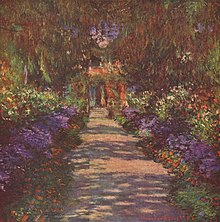



During the last thirty years of his life and creativity, Monet was mainly concerned with the layout and design of his garden in Giverny , which is divided into the ornamental garden called clos normand and the so-called jardin d'eau or water garden with its water lily pond . Both were often used as motifs for his paintings. He bought exotic plants, some of which were only known in France for a few years, and composed the interplay of colors for the flowers.
The painting Path in the Artist's Garden , which was created in 1901 and 1902, is part of a series of almost square pictures with the same motif. It shows a path through the garden leading to the house. The house in the background is in the middle of the line of sight, but is only faintly visible due to the abundance of plants. The path is overgrown by climbing roses, which earned it the name "Rosenweg", and bordered by discounts . The violet color of the flowers is particularly dominant in these beds, while the upper half of the picture is dominated by the color red. On the way, the dark shadows cast by the climbing roses stand out. The picture is symmetrical, but does not appear strict due to the abundance of colors.
Monet employed a gardener solely to tend the water lilies in the water garden. The pond is next to the lily of sea grass and algae revives, while on the banks of reeds , iris and weeping willows grow. Claude Monet gave up the large landscape compositions and focused on the partial view. He concentrated on sections of the water surface. The water landscapes depicted no longer have a horizon, so the sky no longer appears at the top of the picture. The sky appears only as a reflection in the picture, as do trees. Therefore, the pictures can hardly be counted as landscape pictures. Monet used the term “reflex landscapes”. He painted the landscapes not only outdoors, but also in the studio, but always returned to the original motif. The pictures of the water lily pond show the most advanced dissolution of the motif. The broadly layered islands of leaves of the water lilies form horizontal structures, while the reflections in the water create vertical structures. The fact that these geometric structures do not appear boring is mainly due to the loosening effect of the flowers. The color also helps to loosen up. It is split up into many individual nuances so that there are changing shades of color within an image. Claude Monet reproduced the perception of light in such a way that the flickering mosaic of colors can be seen in the picture. The paint was applied by Monet in dots and lines, whereby the first layer of paint is very thin and is covered by the later, thicker layers. Over time, Monet's paint application changed. While the first pictures were painted with short dots and spots, the lines on the later water lily pictures become thicker and form vortex-like structures. In addition, the colors of the image diverged from the actual object color. Furthermore, the formats got bigger and bigger. For example, the water lily decorations with sizes of 2 × 6 meters from 1926 have grown significantly compared to a picture from 1904 with 90 × 92 centimeters.
In addition to the water lily pictures, Monet painted several pictures in his water garden with the title The Japanese Bridge . The bridge was Claude Monet Japanese-style building. It was mainly because of them that the water garden was given the nickname “Japanese Garden”. Monet painted this motif as early as 1895 and 1897. It was not until 1899/1900 that it became a coherent series. The pictures show the bridge from a frontal view from the west side of the pond. The water surface is covered by water lilies and spanned by the bridge. The railing of the bridge alone shows linear structures in the picture. In the background is the lush vegetation on the banks. These are reflected on the water together with the bridge. The water surface and the area around the pond merge with each other due to the homogeneous brushstroke. In this series, too, the sky cannot be seen directly, but only through reflections and light reflections, as flora and water take up the entire surface of the picture. The first pictures in the series contain a strict symmetry that was lifted in the later pictures, as Monet used stronger color contrasts and included the left bank more. After 1908 the motif of the bridge did not appear in Monet's pictures for a long time. It was not until 1920 that he painted more pictures in this series, which, however, differ radically from the earlier ones. They are a single, large mass of color from which the bridge emerges, indicated by two dark arches.
meaning
Artistic importance, attention and notoriety
Claude Monet's work encompasses the influences of several stylistic periods. His early work belongs to the realism from which he developed further and further. He was an important member of the Impressionist group and some of his works are counted among the most important images of this style period. His late work consists mainly of series and garden pictures. This late work by Monet in particular met with little response in the period after his death. The water lily decorations that Claude Monet had given the French state were presented to the public on May 17, 1929 in the Paris Orangery as the “Musée Monet”, but they showed little interest. A retrospective of Monet's was shown in these rooms in 1931, in which his late work was also clearly underrepresented. As a result, the museum held several other exhibitions in these rooms, which contradicted the contract signed with Claude Monet. At a presentation of Flemish carpets in 1935, they were even hung over the pictures. The critics rated the works negatively due to the dissolving form and the particularly intense colors, as they lacked empirical reference to nature. The pictures contradicted the idea that in Impressionism the natural model is reproduced optically exactly. Until the 1980s, a distinction was made in art history, with a few exceptions, between the early Impressionist work, which included the pictures created between 1870 and 1880, and the later work, which was judged negatively. At the beginning of the 1880s, the world appeared increasingly threatening, which promoted the imaginary and visionary as an opposing position. Claude Monet was considered a pioneer by contemporary critics between 1880 and the turn of the century. After 1890 he moved between naturalism and abstraction in his pictures, which prevents the assignment of his later pictures to a style.
Artists such as Max Liebermann , Augusto Giacometti and Lovis Corinth paid tribute to Monet's impressionist works and were influenced by them. This influence of Monet, even after his death, died out with the death of Pierre Bonnard in 1947, who described himself as the "last impressionist". While the Cubists rejected Monet's works because of the dissolution of static forms, foreign painters in particular, such as Wassily Kandinsky , recognized the importance of Claude Monet for modernism.
In the late 1940s and 1950s there was a monetary revival . In 1947, Marc Chagall said of Claude Monet: "Today, Monet is the Michelangelo of our era for me [...]." In his appreciation, however, the later works did not occupy a special position. On the contrary, in 1952 André Masson described the water lily decorations as the “ Sistine Chapel of Impressionism”. Post-war painting in the USA, in which the gesture moved more to the fore and anti-rationalism prevailed, also played a major role in the growing popularity. The interest in the later work came back especially with the abstract painting . Over 300 American artists traveled to Paris in the 1950s, where they also studied Monet. In addition to these developments, the first major solo exhibitions in the 1950s also contributed to the international recognition of Claude Monet's work. The Impressionist exhibition in the Kunsthalle Basel in 1949 has a special position because, mainly due to practical constraints, most of the works on display belonged to the water lily pictures. As a result, the number of visitors to the orangery also increased.
Commercial win
For a long time in his artistic career, Claude Monet lived on the subsistence level. His works, like those of other painters who did not practice the classic painting style popular with the public, were mostly avoided by buyers. With the economic boom after the Franco-Prussian War in 1871, picture prices rose, and works by the Impressionists were also sold at unexpectedly high prices. The art dealer Paul Durand-Ruel , whom Monet had met during his stay in London, bought works by Monet and other critically rejected artists over the years. He didn't pay much, but the regular income allowed Monet to lead a financially secure life. In 1873 Durand-Ruel had to cut back on the Impressionists' support, as the art market also gave way as a result of an economic crisis in France . The drop in prices was particularly great for works by the Impressionists. In 1874, Ernest Hoschedé acquired the picture Impression - Sunrise for 800 francs at the first impressionist exhibition . In 1877 at the foreclosure auction following its bankruptcy, this work only fetched 200 francs. This auction in particular publicly documented the drop in prices for pictures by Impressionist artists. Monet's situation subsequently deteriorated again. At the end of 1878 Monet said: “I am no longer a beginner and it is terrible to be in such a position at my age to have to beg and harass buyers all the time.” It was only after moving to Giverny that Monet's situation improved again when Durand-Ruel was able to fully resume his support for the Impressionists. The works of Monet found increasing recognition and the prices for his pictures rose. For example, he was able to achieve prices of 15,000 francs for the pictures in the Rouen Cathedral series in the mid-1890s. Important art collectors such as Matsukata Kōjirō visited him in his house in Giverny .
At the end of the 1980s, the works of the Impressionists achieved auction results that the majority no longer achieve today. Monet is an exception. One of the water lily pictures from 1907 achieved the price 10.5 million dollars in 1989 and was sold again at Christie's in November 2005 for a profit of two million dollars. This is also due to the fact that only a few works by Monet come onto the market. In 2004 there were 26, 2005 22 and 2006 28 images. In contrast, by the half of 2007 there were already 27. In June 2007, a 1904 painting from the Water Lily series, valued at £ 10 to 15 million, was auctioned at Sotheby’s for £ 18.5 million. The buyer was an Asian collector. It is Monet's fourth most expensive work after the Argenteuil Railway Bridge , which changed hands at Christie's auction house in May 2008 for $ 41.4 million, and a water lily painting from 1900 that was auctioned at Sotheby’s in 1998 for £ 19.8 million . In 2008, the water lily painting Le Bassin aux nympheas fetched 51.7 million euros at Christie's. On November 16, 2016, Christie's New York reported a sale price of US $ 80.45 million for a painting from the "Haystack" series. On May 14, 2019, another picture from this series was even sold for the record price of 110.7 million dollars at the same auction house, after the picture was initially estimated at 55 million euros. On the occasion of the opening of the "Monet.Orte" exhibition in February 2020 in Potsdam, the Hasso Plattner Foundation, founded by Hasso Plattner , identified itself as the buyer of the work.
reception
Claude Monet's works are often used as calendar and postcard motifs in everyday culture . In addition, Claude Monet and his work were the subject of pictures by some of the other impressionists. And his work also had an impact in literature.
literature
The French writer Marcel Proust was inspired by Claude Monet in his work. He had an affinity for Impressionism in general and admired the works of Monet in particular. This is not often mentioned in Proust's works, but there are thematic parallels. In his novel A la recherche du temps perdu , Marcel Proust described phenomena that Monet captured on screen. The narrator in this book gives his impressions of the clouds and the sea in the fictional seaside resort of Balbec verbally. In the fragments of the novel Jean Santeuil , Claude Monet is mentioned by name several times when a collector from Rouen buys paintings by Monet. The narrator also describes in the fragments the impression of five paintings by Monet that they had on him. Monet is also mentioned once in the novel Sodom and Gomorrah , along with the exclamation “Oh, these cathedrals!”. Reiner Jesse published the two-part novel Licht und Schatten about Monet's life with AtheneMedia .
painting
Claude Monet was depicted in several pictures by his artist friends, the Impressionist group. So portrayed Pierre-Auguste Renoir Monet three times. The first picture shows Monet seated and smoking a pipe reading the newspaper and dates from 1872. The second picture, from 1873, shows Monet painting in his garden, with his whole body in the lower one right corner of the picture. The third picture from 1875 shows Monet standing while painting with a palette and brush in his hands. Only his upper body is shown. Also Édouard Manet themed Claude Monet on an image. Monet shows this together with his wife Camille in the studio boat, which he used to paint on the water.
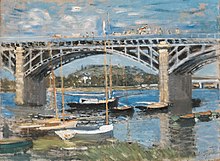
Monet's influence can also be demonstrated in many modern artists. Jackson Pollock 's dense color textures are similar to those of Monet's later works. The screen printing series Flowers by the pop art artist Andy Warhol is also inspired by Claude Monet's water lily pictures. Warhol had previously seen Monet's oil paintings in the Museum of Modern Art .
Movie
In the black-and-white film Ceux de chez nous , a documentary from 1915, Claude Monet is also discussed. The director Sacha Guitry looked at the French culture during the First World War . He focused primarily on Renoir, but also looked at Degas and Monet, who was filmed painting his water lily pictures.
The sky in Monet's painting The Seine at Argenteuil (1873) gave its name to the film Vanilla Sky from 2001. From the turning point of the film, the main actor lives in an illusory world created from his thoughts, which differs from reality because their sky is the same color as the sky in some of Monet's works.
astronomy
The asteroid (6676) Monet was named after Claude Monet on April 4, 1996. As early as 1979, an impact crater on the northern hemisphere of the planet Mercury was named after Claude Monet: Mercury Crater Monet .
Works (selection)
This list contains 39 works by Monet, which represent a representative cross-section of his work. The selection is based on the books Claude Monet by Karin Sagner from DuMont Verlag and Monet by Christoph Heinrich from Taschen Verlag listed under literature .
| image | Title (year of creation) | Size, material | Exhibition / collection / owner |
|---|---|---|---|

|
Breakfast in the countryside (1865/1866) |
248 cm × 217 cm oil on canvas |
Musée d'Orsay in Paris |

|
Camille in a Green Dress (1866) |
231 cm × 151 cm oil on canvas |
Kunsthalle Bremen in Bremen |
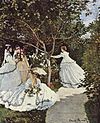
|
Women in the Garden (1866) |
256 cm × 208 cm oil on canvas |
Musée d'Orsay in Paris |

|
The terrace of Sainte-Adresse (1867) |
98 cm × 130 cm oil on canvas |
Metropolitan Museum of Art in New York |

|
The Saint-Germain-l'Auxerrois Church (1867) |
79 cm × 98 cm oil on canvas |
National Gallery in Berlin |

|
The River / On the Banks of Bennecourt (1868) |
81 cm × 100 cm oil on canvas |
Art Institute of Chicago in Chicago |

|
La Grenouillère / The frog pond (1869) |
75 cm × 100 cm oil on canvas |
Metropolitan Museum of Art in New York City |

|
Trouville Beach (1870) |
38 cm × 46 cm oil on canvas |
National Gallery in London |

|
Windmills near Zaandam (1871) |
47 cm × 73 cm oil on canvas |
Van Gogh Museum in Amsterdam |

|
Impression - Sunrise (1872) |
48 cm × 63 cm oil on canvas |
Marmottan Monet Museum in Paris |

|
Poppy field near Argenteuil (1873) |
50 cm × 65 cm oil on canvas |
Musée d'Orsay in Paris |

|
Boulevard des Capucines (1873) |
61 cm × 80 cm oil on canvas |
Pushkin Museum in Moscow |

|
Camille Monet on a Garden Bench (The Bank) (1873) |
61 cm × 80 cm oil on canvas |
Metropolitan Museum of Art in New York |

|
Seine bridge at Argenteuil (1874) |
60 cm × 81.3 cm oil on canvas |
New Pinakothek in Munich |
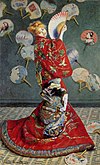
|
Camille in Japanese costume (1875/1876) |
231.5 cm × 142 cm oil on canvas |
Museum of Fine Arts in Boston |

|
Saint-Lazare station, arrival of a train (1877) |
82 cm × 101 cm oil on canvas |
Fogg Art Museum at Harvard University , in Cambridge, Massachusetts |

|
Rue Saint-Denis on the feast of June 30, 1878 (1878) |
76 cm × 52 cm oil on canvas |
Musée des beaux-arts de Rouen in Rouen |

|
Bouquet of sunflowers (1880) |
101 cm × 81 cm oil on canvas |
Metropolitan Museum of Art in New York City |

|
View of Vétheuil (1880) |
60 cm × 100 cm oil on canvas |
Old National Gallery Berlin |

|
Customsman's Cabin in Verengeville (1882) |
60 cm × 78 cm oil on canvas |
Boijmans Van Beuningen Museum in Rotterdam |

|
Stormy Sea at Etretat (1883) |
81 cm × 100 cm oil on canvas |
Musée des Beaux-Arts in Lyon |

|
Bordighera (1884) |
64.8 cm × 81.3 cm oil on canvas |
The Art Institute of Chicago Mr. and Mrs. Potter Palmer Collection |

|
Woman with a Parasol (1886) |
131 cm × 88 cm oil on canvas |
Musée d'Orsay in Paris |
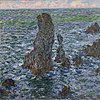
|
Rock pyramid at Port-Coton in rough seas (1886) |
65 cm × 80 cm oil on canvas |
Pushkin Museum in Moscow |

|
Young Girls in a Boat (1887) |
145.5 cm × 133.5 cm oil on canvas |
National Museum of Western Art in Tokyo |



|
Grain rack (1890/1891) |
different formats oil on canvas |
different exhibition locations |

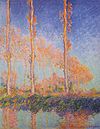

|
Poplars (1891) |
different formats oil on canvas |
different exhibition locations |



|
Rouen Cathedral (1891-1894) |
different formats oil on canvas |
different exhibition locations |

|
Seinearm at Giverny (1897) |
81 cm × 92 cm oil on canvas |
Museum of Fine Arts in Boston |

|
Water lilies (1897–1899) |
81 cm × 100 cm oil on canvas |
Galleria Nazionale d'Arte Moderna in Rome |

|
The Japanese Bridge (1899) |
89 cm × 93 cm oil on canvas |
National Gallery in London |
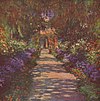
|
Path in the Artist's Garden (1902) |
89 cm × 92 cm oil on canvas |
Belvedere in Vienna |

|
The Parliament of London, Sunset (1902) |
81 cm × 92 cm oil on canvas |
National Gallery of Art in Washington, DC |

|
The Palazzo da Mula (1908) |
62 cm × 81 cm oil on canvas |
National Gallery of Art in Washington DC |

|
Weeping willow (1918/1919) |
89 cm × 115 cm oil on canvas |
Kimbell Art Museum , in Fort Worth , Texas |
literature
- Janice Anderson: Monet. Verlag Edition XXL, 2005, ISBN 3-89736-332-1 .
- Matthias Arnold: Claude Monet. 2nd Edition. Rowohlt-Verlag, Reinbek 2003, ISBN 3-499-50402-2 .
- Gerhard Finckh (Ed.): Claude Monet. Catalog for the exhibition in the Von der Heydt Museum , Wuppertal 2009, ISBN 978-3-89202-075-2 .
- Dorothee Hansen and Wulf Herzogenrath (eds.): Monet and Camille - portraits of women in impressionism . Hirmer Verlag, Munich 2005, ISBN 3-7774-2705-5 .
- Christoph Heinrich : Monet . Taschen-Verlag, Cologne 2006, ISBN 3-8228-6368-8 .
- Karin Sagner-Düchting : Claude Monet and the Modern Age . Prestel Verlag , Munich 2001, ISBN 3-7913-2614-7 .
- Karin Sagner: Claude Monet. DuMont, Cologne 2005, ISBN 3-8321-7598-9 .
- Karin Sagner: Claude Monet in Giverny. 4th edition. Prestel Verlag, Munich 2006, ISBN 978-3-7913-3438-7 .
- Karin Sagner: Claude Monet. 1840-1926. A feast for the eyes. Taschen, Cologne 2006, ISBN 978-3-8228-5021-3 (original edition: 1990).
- Susanne Weiß: Claude Monet. A distanced view of the city and the countryside (works 1859–1889) . Dietrich Reimer Verlag , Berlin 1997, ISBN 3-496-01173-4 .
- Daniel Wildenstein : Monet. 4 volumes. Taschen-Verlag, Cologne 1996, ISBN 3-8228-8725-0 .
Documentaries
- Monet and the discovery of London. (OT: Monet, la révélation londonienne. ) Documentary, Germany, 2018, 13:07 min., Script and director: David Dietz, production: arte , series: Stadt Land Kunst (OT: Invitation au voyage ), first broadcast: 16. October 2018 at arte, table of contents and online video available until October 16, 2020.
- The Water Lilies - Claude Monet's Legacy. (OT: Clemenceau dans le jardin de Monet - Chronique d'une amitié. ) Documentary, France, 2018, 51:58 min., Written and directed: François Prodromidès, production: Zadig Productions, arte France, first broadcast: November 11, 2018 at arte, table of contents from ARD . With archive recordings; on Monet's "deep friendship" with Prime Minister Georges Clemenceau .
Audio books
- Camille Monet and the Others - The Models of the Impressionists . This CD was created to accompany the exhibition Monet and Camille - Women Portraits in Impressionism in the Kunsthalle Bremen (= Green Edition ). A coproduction with the Kunsthalle Bremen, Der Sprachraum, Berlin 2005, ISBN 978-3-936301-06-9 .
Web links
- Claude Monet at artfacts.net
- Literature by and about Claude Monet in the catalog of the German National Library
- Works by and about Claude Monet in the German Digital Library
- Search for Claude Monet in the SPK digital portal of the Prussian Cultural Heritage Foundation
- Works by Claude Monet at Zeno.org .
- Monet's collection of Japanese woodblock prints (English)
Individual evidence
- ^ Matthias Arnold: Claude Monet , Rowohlt, Hamburg, 1998, page 9.
- ^ Sylvie Patin: Monet "un oeil ..., mais bon Dieu, quel oeil!" , Collection Découvertes Gallimard, 1993, page 14.
- ^ William C. Seitz: Famous Painters at a Glance - Claude Monet , DuMont, Cologne 1999, ISBN 3-7701-2543-6 , page 8.
- ^ Matthias Arnold: Claude Monet , Rowohlt, Hamburg, 1998, pages 9 and 10.
- ↑ From an interview with Monet from 1900 based on Charles F. Stuckey: Claude Monet 1840–1926 , Könemann, Cologne, 1996, page 204 ff.
- ↑ John Rewald: The History of Impressionism . DuMont Buchverlag, Cologne 1979. 7th edition 2001, page 29.
- ↑ Dorothee Hansen and Wulf Herzogenrath (eds.): Monet and Camille - portraits of women in impressionism . Hirmer Verlag , Munich 2005, page 23.
- ^ Matthias Arnold: Claude Monet , p. 22.
- ↑ Christoph Heinrich : Monet . Taschen, Cologne 2006, page 10.
- ↑ Christoph Heinrich: Monet . Taschen, Cologne 2006, page 20.
- ↑ Christoph Heinrich: Monet . Taschen, Cologne 2006, page 48.
- ↑ Claude Monet, Twilight, Venice, c. 1908. ( Memento from April 1, 2015 in the Internet Archive ). In: Bridgestone Museum of Art .
- ↑ Note: There is no evidence for the frequently expressed assumption that Camille was the model for all female figures in the picture; see Karin Sagner : Library of Great Painter - Claude Monet , DuMont, Cologne 2005, page 24.
- ↑ William C. Seitz: Famous painters at a glance - Claude Monet , DuMont, Koln 1999, pages 30 and 31.
- ↑ Christoph Heinrich: Monet . Taschen, Cologne 2006, page 17.
- ↑ Sandro Bocola: Die Kunst der Moderne - On the structure and dynamics of their development - From Goya to Beuys , Prestel Verlag , Munich, 1994, pages 127 and 128.
- ↑ Georg Schmidt: Small history of modern painting , Friedrich-Reinhard-Verlag, Basel, 1979, pages 22 to 29.
- ↑ Sandro Bocola: Die Kunst der Moderne - On the structure and dynamics of their development - From Goya to Beuys , Prestel Verlag, Munich, 1994, page 130.
- ↑ Christoph Heinrich: Monet . Taschen, Cologne 2006, page 22.
- ↑ Christoph Heinrich: Monet . Taschen, Cologne 2006, page 32.
- ↑ Christoph Heinrich: Monet . Taschen, Cologne 2006, page 41.
- ↑ Karin Sagner: Claude Monet . DuMont, Cologne 2005, page 64.
- ↑ Gottfried Boehm : Moments - Monet's transformation of the Venetian vedute . In: Martin Schwander (Ed. On behalf of the Fondation Beyeler ): Venice. From Canaletto and Turner to Monet . Hatje Cantz Verlag, Ostfildern 2008, ISBN 978-3-7757-2240-7 , p. 193.
- ↑ Karin Sagner-Düchting : Claude Monet and Modernity . Prestel Verlag, Munich 2001, page 20.
- ↑ Karin Sagner-Düchting: Claude Monet and Modernity . Prestel Verlag, Munich 2001, page 22.
- ↑ Karin Sagner: Claude Monet . DuMont, Cologne 2005, page 23.
- ^ Peter H. Feist: Pierre-Auguste Renoir . Taschen, Cologne 2006.
- ↑ Christoph Heinrich: Monet . Taschen, Cologne 2006, page 48.
- ↑ Carol Vogel: Monet and Rodin Set Price Records at Christie's. In: New York Times , May 7, 2008.
- ↑ Monet: “Nymphéas” auctioned for 27.4 million euros. In: The press . June 20, 2007. Retrieved November 21, 2018 .
- ↑ Alexandra Matzner: Auction world record for Monet's "Haystack". In: ArtinWords , November 17, 2016.
- ↑ Monet picture auctioned: The most expensive haystack of all time. In: Tagesschau.de . May 15, 2019, accessed February 21, 2020 .
- ^ Halina Loft: Monet's "Meules" Sells for Astonishing $ 110.7 million, a New Artist Record. In: sothebys.com. May 14, 2019, accessed February 21, 2020 .
- ↑ Expensive haystack - Confirmed: Plattner bought the record Monet in 2019. In: monopol - magazine for art and life. Res Publica Verlags GmbH, February 20, 2020, accessed on February 22, 2020 .
- ↑ Claude Monet, Marcel Proust, The Norman Coast and the Loss of the Borderline ( Memento of January 19, 2012 in the Internet Archive ), page 1.
- ↑ Claude Monet, Marcel Proust, The Norman Coast and the Loss of the Border Line ( Memento of January 19, 2012 in the Internet Archive ), page 5.
- ↑ Figures: Andy Warhol, Portfolio Flowers , 1970. In: MoMA , accessed on November 21, 2018.
- ^ Lutz D. Schmadel : Dictionary of Minor Planet Names. Springer, Heidelberg 2012, 6th edition, page 28, (English).
- ^ Claude Monet in the Gazetteer of Planetary Nomenclature of the IAU (WGPSN) / USGS
| personal data | |
|---|---|
| SURNAME | Monet, Claude |
| ALTERNATIVE NAMES | Monet, Oscar-Claude (maiden name) |
| BRIEF DESCRIPTION | French impressionism painter |
| DATE OF BIRTH | November 14, 1840 |
| PLACE OF BIRTH | Paris |
| DATE OF DEATH | December 5, 1926 |
| Place of death | Giverny |
